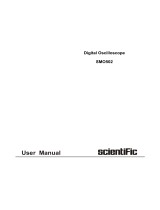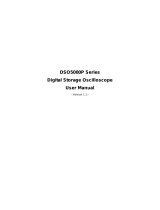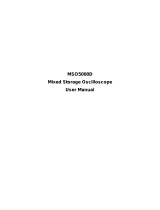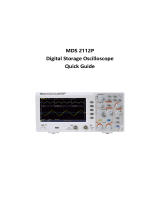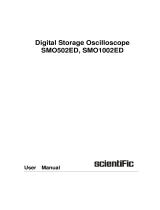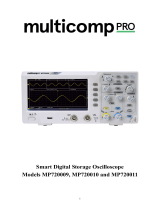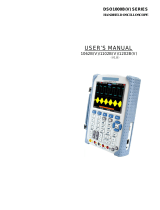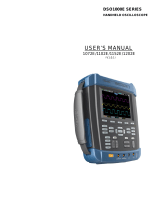Page is loading ...

User Manual
TDS 200-Series
Digital Real-Time Oscilloscope
071-0398-03
This document supports firmware version
FV:v1.00 and above.
www.tektronix.com

Copyright © Tektronix, Inc. All rights reserved.
Tektronix products are covered by U.S. and foreign patents, issued and
pending. Information in this publication supercedes that in all previously
published material. Specifications and price change privileges reserved.
Tektronix, Inc., P.O. Box 500, Beaverton, OR 97077
TEKTRONIX and TEK are registered trademarks of Tektronix, Inc.

WARRANTY SUMMARY
(TDS 200-Series Digitizing Oscilloscope)
Tektronix warrants that the products that it manufactures and sells will be free from defects
in materials and workmanship for a period of three (3) years from the date of shipment
from an authorized Tektronix distributor. If a product or CRT proves defective within the
respective period, Tektronix will provide repair or replacement as described in the complete
warranty statement.
To arrange for service or obtain a copy of the complete warranty statement, please contact
your nearest Tektronix sales and service office.
EXCEPT AS PROVIDED IN THIS SUMMARY OR THE APPLICABLE WARRANTY
STATEMENT, TEKTRONIX MAKES NO WARRANTY OF ANY KIND, EXPRESS
OR IMPLIED, INCLUDING WITHOUT LIMITATION THE IMPLIED WARRANTIES
OF MERCHANTABILITY AND FITNESS FOR A PARTICULAR PURPOSE. IN NO
EVENT SHALL TEKTRONIX BE LIABLE FOR INDIRECT, SPECIAL OR
CONSEQUENTIAL DAMAGES.

WARRANTY SUMMARY
(P2100 Probe)
Tektronix warrants that the products that it manufactures and sells will be free from defects
in materials and workmanship for a period of one (1) year from the date of shipment. If a
product proves defective within the respective period, Tektronix will provide repair or
replacement as described in the complete warranty statement.
To arrange for service or obtain a copy of the complete warranty statement, please contact
your nearest Tektronix sales and service office.
EXCEPT AS PROVIDED IN THIS SUMMARY OR THE APPLICABLE WARRANTY
STATEMENT, TEKTRONIX MAKES NO WARRANTY OF ANY KIND, EXPRESS
OR IMPLIED, INCLUDING WITHOUT LIMITATION THE IMPLIED WARRANTIES
OF MERCHANTABILITY AND FITNESS FOR A PARTICULAR PURPOSE. IN NO
EVENT SHALL TEKTRONIX BE LIABLE FOR INDIRECT, SPECIAL OR
CONSEQUENTIAL DAMAGES.

TDS 200-Series Digital Oscilloscope User Manual
i
Table of Contents
General Safety Summary v. . . . . . . . . . . . . . . . . . . . . . . . . . . .
Contacting Tektronix vii. . . . . . . . . . . . . . . . . . . . . . . . . . . . . . . .
Product End-of-Life Handling viii. . . . . . . . . . . . . . . . . . . . . . . .
Getting Started 1. . . . . . . . . . . . . . . . . . . . . . . . . . . . . . . . . . . . .
General Features 2. . . . . . . . . . . . . . . . . . . . . . . . . . . . . . . . . . . .
Installation 3. . . . . . . . . . . . . . . . . . . . . . . . . . . . . . . . . . . . . . . . .
Power Cord 3. . . . . . . . . . . . . . . . . . . . . . . . . . . . . . . . . . . . .
Security Loop 3. . . . . . . . . . . . . . . . . . . . . . . . . . . . . . . . . . . .
Extension Modules 4. . . . . . . . . . . . . . . . . . . . . . . . . . . . . . . . . .
Functional Check 5. . . . . . . . . . . . . . . . . . . . . . . . . . . . . . . . . . . .
Probe Compensation 6. . . . . . . . . . . . . . . . . . . . . . . . . . . . . . . . .
Self Calibration 7. . . . . . . . . . . . . . . . . . . . . . . . . . . . . . . . . . . . .
Probe Safety 7. . . . . . . . . . . . . . . . . . . . . . . . . . . . . . . . . . . . . . . .
Probe Attenuation Setting 8. . . . . . . . . . . . . . . . . . . . . . . . . . . . .
Basic Concepts 9. . . . . . . . . . . . . . . . . . . . . . . . . . . . . . . . . . . . .
Triggering 10. . . . . . . . . . . . . . . . . . . . . . . . . . . . . . . . . . . . . . . . .
Source 10. . . . . . . . . . . . . . . . . . . . . . . . . . . . . . . . . . . . . . . . .
Types 11. . . . . . . . . . . . . . . . . . . . . . . . . . . . . . . . . . . . . . . . . .
Modes 11. . . . . . . . . . . . . . . . . . . . . . . . . . . . . . . . . . . . . . . . . .
Holdoff 13. . . . . . . . . . . . . . . . . . . . . . . . . . . . . . . . . . . . . . . . .
Coupling 14. . . . . . . . . . . . . . . . . . . . . . . . . . . . . . . . . . . . . . . .
Position 14. . . . . . . . . . . . . . . . . . . . . . . . . . . . . . . . . . . . . . . .
Slope and Level 14. . . . . . . . . . . . . . . . . . . . . . . . . . . . . . . . . .
Acquiring Data 15. . . . . . . . . . . . . . . . . . . . . . . . . . . . . . . . . . . . . .
Acquisition Modes 15. . . . . . . . . . . . . . . . . . . . . . . . . . . . . . . .
Time Base 16. . . . . . . . . . . . . . . . . . . . . . . . . . . . . . . . . . . . . .
Scaling and Positioning Waveforms 16. . . . . . . . . . . . . . . . . . . . .
Vertical Scale and Position 17. . . . . . . . . . . . . . . . . . . . . . . . . .
Horizontal Scale and Position; Pretrigger Information 17. . . .
Taking Measurements 20. . . . . . . . . . . . . . . . . . . . . . . . . . . . . . . .
Graticule 20. . . . . . . . . . . . . . . . . . . . . . . . . . . . . . . . . . . . . . . .
Cursors 21. . . . . . . . . . . . . . . . . . . . . . . . . . . . . . . . . . . . . . . . .
Automated 21. . . . . . . . . . . . . . . . . . . . . . . . . . . . . . . . . . . . . .
Setting Up the Oscilloscope 21. . . . . . . . . . . . . . . . . . . . . . . . . . . .
Using Autoset 22. . . . . . . . . . . . . . . . . . . . . . . . . . . . . . . . . . . .
Saving a Setup 22. . . . . . . . . . . . . . . . . . . . . . . . . . . . . . . . . . .
Recalling a Setup 22. . . . . . . . . . . . . . . . . . . . . . . . . . . . . . . . .
Defaults (Factory Setup) 22. . . . . . . . . . . . . . . . . . . . . . . . . . .

Table of Contents
ii
TDS 200-Series Digital Oscilloscope User Manual
Operating Basics 23. . . . . . . . . . . . . . . . . . . . . . . . . . . . . . . . . . .
Display Area 24. . . . . . . . . . . . . . . . . . . . . . . . . . . . . . . . . . . . . . .
Using the Menu System 26. . . . . . . . . . . . . . . . . . . . . . . . . . . . . . .
Circular List Menu Boxes 26. . . . . . . . . . . . . . . . . . . . . . . . . .
Action Button Menu Boxes 27. . . . . . . . . . . . . . . . . . . . . . . . .
Radio Button Menu Boxes 27. . . . . . . . . . . . . . . . . . . . . . . . . .
Page Selection Menu Boxes 27. . . . . . . . . . . . . . . . . . . . . . . . .
Waveform Displays 28. . . . . . . . . . . . . . . . . . . . . . . . . . . . . . . . . .
Vertical Controls 29. . . . . . . . . . . . . . . . . . . . . . . . . . . . . . . . . . . .
Horizontal Controls 31. . . . . . . . . . . . . . . . . . . . . . . . . . . . . . . . . .
Trigger Controls 32. . . . . . . . . . . . . . . . . . . . . . . . . . . . . . . . . . . . .
Menu and Control Buttons 33. . . . . . . . . . . . . . . . . . . . . . . . . . . . .
Connectors 35. . . . . . . . . . . . . . . . . . . . . . . . . . . . . . . . . . . . . . . . .
Application Examples 37. . . . . . . . . . . . . . . . . . . . . . . . . . . . . . .
Taking Simple Measurements 38. . . . . . . . . . . . . . . . . . . . . . . . . .
Using Autoset 38. . . . . . . . . . . . . . . . . . . . . . . . . . . . . . . . . . . .
Taking Automatic Measurements 39. . . . . . . . . . . . . . . . . . . .
Measuring Two Signals 40. . . . . . . . . . . . . . . . . . . . . . . . . . . .
Taking Cursor Measurements 42. . . . . . . . . . . . . . . . . . . . . . . . . .
Measuring Pulse Width 42. . . . . . . . . . . . . . . . . . . . . . . . . . . .
Measuring Rise Time 43. . . . . . . . . . . . . . . . . . . . . . . . . . . . . .
Measuring Ring Frequency 45. . . . . . . . . . . . . . . . . . . . . . . . .
Measuring Ring Amplitude 46. . . . . . . . . . . . . . . . . . . . . . . . .
Analyzing Signal Detail 47. . . . . . . . . . . . . . . . . . . . . . . . . . . . . . .
Looking at a Noisy Signal 47. . . . . . . . . . . . . . . . . . . . . . . . . .
Separating the Signal from Noise 48. . . . . . . . . . . . . . . . . . . .
Capturing a Single-Shot Signal 49. . . . . . . . . . . . . . . . . . . . . . . . .
Optimizing the Acquisition 50. . . . . . . . . . . . . . . . . . . . . . . . .
Measuring Propagation Delay 51. . . . . . . . . . . . . . . . . . . . . . . . . .
Triggering on a Video Signal 53. . . . . . . . . . . . . . . . . . . . . . . . . . .
Triggering on Video Fields 54. . . . . . . . . . . . . . . . . . . . . . . . .
Triggering on Video Lines 54. . . . . . . . . . . . . . . . . . . . . . . . . .
Using the Window Function to See Waveform Details 55. . . .
Triggering on Odd or Even Video Fields 57. . . . . . . . . . . . . . .
Analyzing a Differential Communication Signal 60. . . . . . . . . . .
TDS 210 and TDS 220 (Firmware V 2.00 and Above), and
TDS 224 (All Versions) Oscilloscopes 61. . . . . . . . . . . . . . . .
TDS 210 and TDS 220 Oscilloscopes (Firmware Below
V 2.00) without a TDS2MM 62. . . . . . . . . . . . . . . . . . . . . . . .
TDS 210 and TDS 220 Oscilloscopes (Firmware Below
V 2.00) with a TDS2MM 62. . . . . . . . . . . . . . . . . . . . . . . . . . .
Viewing Impedance Changes in a Network 63. . . . . . . . . . . . . . . .

Table of Contents
TDS 200-Series Digital Oscilloscope User Manual
iii
Reference 65. . . . . . . . . . . . . . . . . . . . . . . . . . . . . . . . . . . . . . . . .
Acquire 66. . . . . . . . . . . . . . . . . . . . . . . . . . . . . . . . . . . . . . . . . . .
Autoset 70. . . . . . . . . . . . . . . . . . . . . . . . . . . . . . . . . . . . . . . . . . . .
Cursors 71. . . . . . . . . . . . . . . . . . . . . . . . . . . . . . . . . . . . . . . . . . . .
Display 72. . . . . . . . . . . . . . . . . . . . . . . . . . . . . . . . . . . . . . . . . . . .
Horizontal 74. . . . . . . . . . . . . . . . . . . . . . . . . . . . . . . . . . . . . . . . .
Math 76. . . . . . . . . . . . . . . . . . . . . . . . . . . . . . . . . . . . . . . . . . . . . .
TDS 210 and TDS 220 (Firmware V 2.00 and Above) and
TDS 224 (All Versions) Oscilloscopes , 76. . . . . . . . . . . . . . . .
TDS 210 and TDS 220 Oscilloscopes (Firmware Below
V 2.00) without a TDS2MM 77. . . . . . . . . . . . . . . . . . . . . . . .
TDS 210 and TDS 220 Oscilloscopes (Firmware Below
V 2.00) with a TDS2MM 77. . . . . . . . . . . . . . . . . . . . . . . . . .
Measure 79. . . . . . . . . . . . . . . . . . . . . . . . . . . . . . . . . . . . . . . . . . .
Save/Recall 81. . . . . . . . . . . . . . . . . . . . . . . . . . . . . . . . . . . . . . . .
Trigger Controls 83. . . . . . . . . . . . . . . . . . . . . . . . . . . . . . . . . . . . .
Utility 87. . . . . . . . . . . . . . . . . . . . . . . . . . . . . . . . . . . . . . . . . . . . .
Vertical 89. . . . . . . . . . . . . . . . . . . . . . . . . . . . . . . . . . . . . . . . . . . .
Hard Copy 90. . . . . . . . . . . . . . . . . . . . . . . . . . . . . . . . . . . . . . . . .
Appendix A: Specifications 91. . . . . . . . . . . . . . . . . . . . . . . . . . .
Appendix B: Accessories 103. . . . . . . . . . . . . . . . . . . . . . . . . . . . .
Appendix C: General Care and Cleaning 107. . . . . . . . . . . . . . .
Glossary 109. . . . . . . . . . . . . . . . . . . . . . . . . . . . . . . . . . . . . . . . . .
Index 115. . . . . . . . . . . . . . . . . . . . . . . . . . . . . . . . . . . . . . . . . . . . .

Table of Contents
iv
TDS 200-Series Digital Oscilloscope User Manual

TDS 200-Series Digital Oscilloscope User Manual
v
General Safety Summary
Review the following safety precautions to avoid injury and prevent
damage to this product or any products connected to it. To avoid
potential hazards, use this product only as specified.
Only qualified personnel should perform service procedures.
To Avoid Fire or Personal Injury
Use Proper Power Cord. Use only the power cord specified for this
product and certified for the country of use.
Connect and Disconnect Properly. Do not connect or disconnect probes
or test leads while they are connected to a voltage source.
Ground the Product. This product is grounded through the grounding
conductor of the power cord. To avoid electric shock, the grounding
conductor must be connected to earth ground. Before making
connections to the input or output terminals of the product, ensure
that the product is properly grounded.
Connect the Probe Properly. The probe ground lead is at ground
potential. Do not connect the ground lead to an elevated voltage.
Observe All Terminal Ratings. To avoid fire or shock hazard, observe all
ratings and marking on the product. Consult the product manual for
further ratings information before making connections to the product.
Do Not Operate Without Covers. Do not operate this product with
covers or panels removed.
Use Proper Fuse. Use only the fuse type and rating specified for this
product.
Avoid Exposed Circuitry. Do not touch exposed connections and
components when power is present.
Do Not Operate With Suspected Failures. If you suspect there is damage
to this product, have it inspected by qualified service personnel.
Provide Proper Ventilation. Refer to the manual’s installation
instructions for details on installing the product so it has proper
ventilation.

General Safety Summary
vi
TDS 200-Series Digital Oscilloscope User Manual
Do Not Operate in Wet/Damp Conditions.
Do Not Operate in an Explosive Atmosphere.
Keep Product Surfaces Clean and Dry.
Safety Terms and Symbols
Terms in This Manual. These terms may appear in this manual:
WARNING. Warning statements identify conditions or practices that
could result in injury or loss of life.
CAUTION. Caution statements identify conditions or practices that
could result in damage to this product or other property.
Terms on the Product. These terms may appear on the product:
DANGER indicates an injury hazard immediately accessible as you
read the marking.
WARNING indicates an injury hazard not immediately accessible as
you read the marking.
CAUTION indicates a hazard to property including the product.
Symbols on the Product. These symbols may appear on the product:
Protective Ground
(Earth) Terminal
CAUTION
Refer to Manual
Measurment
Ground Terminal
Measurment
Input Terminal

TDS 200-Series Digital Oscilloscope User Manual
vii
Contacting Tektronix
Product
support
For questions about using Tektronix measurement
products, call toll free in North America:
1-800-833–9200
6:00 a.m. – 5:00 p.m. Pacific time
Or contact us by e-mail:
For product support outside of North America,
contact your local Tektronix distributor or sales
office.
Service
support
Tektronix offers extended warranty and calibration
programs as options on many products. Contact
your local Tektronix distributor or sales office.
For a listing of worldwide service centers, visit our
web site.
For other
information
In North America:
1-800–833–9200
An operator can direct your call.
To write us Tektronix, Inc.
P.O. Box 500
Beaverton, OR 97077-0001
USA
Web site www.tektronix.com

Contacting Tektronix
viii
TDS 200-Series Digital Oscilloscope User Manual
Product End-of-Life Handling
Components that Contain Mercury. The cold cathode fluorescent tube
located in the liquid crystal display backlight contains trace elements
of mercury. When you are ready to reclaim the instrument, you must
properly transfer it according to local regulations concerning
mercury-containing equipment or ship the instrument to the
Tektronix Recycling Operations (RAMS). You can contact
Tektronix for the RAMS shipping address and instructions.

TDS 200-Series Digital Oscilloscope User Manual
1
Getting Started
TDS 200-Series Digital Oscilloscopes are small, lightweight,
benchtop packages that you can use to take ground-referenced
measurements. The TDS 210 and TDS 220 oscilloscopes have
two-channels; the TDS 224 has four channels.
In addition to the list of general features, this section covers the
following topics:
H How to install your product
H How to add extended functions
H How to perform a brief functional check
H How to compensate probes
H How to use the self calibration routine
H How to match your probe attenuation factor
NOTE. To select a display language, push the UTILITY menu button,
and then push the Language menu box item to select the appropriate
language.

Getting Started
2
TDS 200-Series Digital Oscilloscope User Manual
General Features
H 100 MHz (TDS 220 or TDS 224) or 60 MHz (TDS 210)
bandwidth with selectable 20 MHz bandwidth limit
H 1 GS/s sample rate and 2,500 point record length for each
channel
H Cursors with readout
H Five automated measurements
H High-resolution, high-contrast LCD display with temperature
compensation and replaceable back light
H Setup and waveform storage
H Autoset for quick setup
H Waveform averaging and peak detection
H Digital real-time oscilloscope
H Dual time base
H Video trigger capability
H RS-232, GPIB, and Centronics communication ports easily added
with optional extension modules
H Variable persistence display
H User interface available in ten user-selectable languages

Getting Started
TDS 200-Series Digital Oscilloscope User Manual
3
Installation
Power Cord
Use only power cords designed for your oscilloscope. Use a power
source that delivers 90 to 264 VAC
RMS
, 45 to 440 Hz. Refer to
page 105 for a list of available power cords.
Use the power cord notch to help route the cord to the rear of the
instrument and avoid inadvertently disconnecting the power source.
Securing cable
Power cord
notch
Security Loop
Use the built-in cable channels to secure both your instrument and
extension module to your location.

Getting Started
4
TDS 200-Series Digital Oscilloscope User Manual
Extension Modules
You can increase the feature set of your oscilloscope by inserting an
extension module. Refer to page 103 for information about the
available modules.
CAUTION. Electrostatic discharge (ESD) can damage components in
the extension module and the oscilloscope. Do not operate your
instrument with the extension module connector exposed.
Modules slide
in and out

Getting Started
TDS 200-Series Digital Oscilloscope User Manual
5
Functional Check
Perform this quick functional check to verify that your instrument is
operating correctly.
PASSED
ON/OFF
button
1. Turn on the instrument.
Wait until the display shows that all self
tests passed. Push the SAVE/RECALL
button, select Setups in the top menu box
and push the Recall Factory menu box.
The default Probe menu attenuation
setting is 10X.
CH 1
PROBE COMP
2. Set the switch to 10X on the P2100 probe
and connect the probe to channel 1 on the
oscilloscope. To do this, align the slot in
the probe connector with the key on the
CH 1 BNC, push to connect, and twist to
the right to lock the probe in place.
Attach the probe tip and reference lead to
the PROBE COMP connectors.
3. Push the AUTOSET button. Within a few
seconds, you should see a square wave in
the display (approximately 5 V at 1 kHz
peak-to-peak).
Push the CH 1 MENU button twice to turn
off channel 1, push the CH 2 MENU
button to turn on channel 2, repeat steps 2
and 3. For TDS 224, repeat for CH 3 and
CH 4.

Getting Started
6
TDS 200-Series Digital Oscilloscope User Manual
Probe Compensation
Perform this adjustment to match your probe to the input channel.
This should be done whenever you attach a probe for the first time to
any input channel.
CH 1
PROBE
COMP
AUTOSET
button
1. Set the Probe menu attenuation to 10X.
Set the switch to 10X on the P2100 probe
and connect the probe to channel 1 on the
oscilloscope. If you use the probe hook-
tip, ensure a proper connection by firmly
inserting the tip onto the probe.
Attach the probe tip to the PROBE COMP
5V connector and the reference lead to the
PROBE COMP Ground connector, turn on
the channel, and then press AUTOSET.
Overcompensated
Compensated correctly
Undercompensated
2. Check the shape of the displayed
waveform.
3. If necessary, adjust your probe.
Repeat as necessary.

Getting Started
TDS 200-Series Digital Oscilloscope User Manual
7
Self Calibration
The self calibration routine lets you quickly optimize the oscillo-
scope signal path for maximum measurement accuracy. You can run
the routine at anytime but you should always run the routine if the
ambient temperature changes by 5_ C or more.
To compensate the signal path, disconnect any probes or cables from
the input connectors. Then, press the UTILITY button and select Do
Self Cal to confirm that you are ready to proceed.
Probe Safety
A guard around the probe body provides a finger barrier for
protection from electric shock.
Finger guard
WARNING. To avoid electric shock when using the probe, keep fingers
behind the guard on the probe body.
To avoid electric shock while using the probe, do not touch metallic
portions of the probe head while it is connected to a voltage source.
Connect the probe to the instrument and connect the ground terminal
to ground before you take any measurements.

Getting Started
8
TDS 200-Series Digital Oscilloscope User Manual
Probe Attenuation Setting
Probes are available with various attenuation factors which affect the
vertical scale of the signal.
To change (or check) the probe attenuation setting, press the
VERTICAL MENU button (of the channel you are using), and then
press the menu selection next to Probe until the correct setting is
displayed.
This setting remains in effect until changed again.
NOTE. The default Probe menu attenuation setting is 10X when the
oscilloscope is shipped.
Be sure that the Attenuation switch on the P2100 probe is set to
match the Probe menu selection in the oscilloscope. The probe
switch settings are 1X and 10X.
Attenuation switch
NOTE. When the Attenuation switch is set to 1X, the P2100 probe
limits the bandwidth of the oscilloscope to 7 MHz. To use the full
bandwidth of the oscilloscope, be sure to set the switch to 10X.
/
